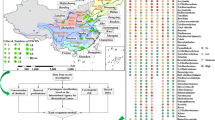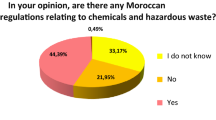Abstract
The Ministry of the Environment in Korea supports investigation of various substances that are potential contaminants of the environment and could cause adverse effects on the environment and/or human health and to list Priority Substances (PSL). The present study for PSL is aimed at estimating the new PSL for industrial areas or assessing the risk of refining processes for selecting priority substances in order to obtain better criteria of quality data. The present study lists 81 major priority substances among 106 candidate substances and scores with weight factors to CHEMS-1 based on amounts of materials in circulation and emissions levels. Of the 81 chemicals, 80% are classified as carcinogens, potentially causing acute oral toxicity among those within the 1st grade of data quality criteria for materials. For data quality criteria of items, BOD or hydrolysis half-life is the lowest 40% and acute oral toxicity is the highest 90%.
Similar content being viewed by others
References
Bodar, C.W.M., Berthault, F., Bruijn, J.H.M., de Leeuwen, C. J. van, Pronk, M. E. J. and Vermeire, T. G., “Evaluation of EU Risk Assessments Existing Chemicals (EC Regulation 793/93),”Chemosphere,53, 1039 (2003).
Chah, S.W., Joo, C.K., Park, H. S., Park, S. J., Kim, P. J., Lee, S.M., Choi, K.H. and Yi, J.H., “Methodology to Determine the Order of Priority for Environmental Pollutants and Selection of Major Pollutants for Metropolitan and Industrial Areas,”Korean Chem. Eng. Res.,41(3), 357 (2003).
Hughes, K., Meek, M. E. and Walker, M., “Health Risk Assessment of 1,3-Butadiene as a Priority Substance in Canada,”Chemico-Biological Interactions,135–136, 109 (2001).
Kappes, D. and Rasmussen, K., “Prioritisation of Existing Biocidal Active Substances in the European Union,”Environmental Science & Policy,6, 521 (2003).
Khan, F. I., Rani, J. D. and Abbasi, S. A., “Accident Simulation as a Tool for Assessing and Controlling Environmental Risks in Chemical Process Industries: A Case Study,”Korean J. Chem. Eng.,15(2), 124 (1998).
Kim, K.H., Shin, D. and Yoon, E. S., “Risk Analysis Using Automatically Synthesized Robust Accident Scenarios and Consequence Assessment for Chemical Processes: Process Partition and Consequence analysis Approach,”Korean J. Chem. Eng.,20(6), 992 (2003).
Lerche, D., SØrensen, P. B., Larsen, H. S., Carlsen, L. and Nielsen, O. J., “Comparison of the Combined Monitoring-based and Modelingbased Priority Setting Scheme with Partial Order Theory and Random Linear Extensions for Ranking of Chemical Substances,”Chemosphere,49, 637 (2002).
Meek, B., “Assessments of Priority Substances under the Canadian Environmental Protection Act Variations in Exposure and Response,”Environmental Toxicology and Pharmacology,2, 111 (1996).
Meek, M. E., “Application of Uncertainty Factors in the Priority Substances Program and International Harmonization,”Human and Ecological Risk Assessment,5, Issue 5, 1013 (1999).
Meek, M. E. and Hughes, K., “Approach to Health Risk Determination for Metals and their Compounds under the Canadian Environmental Protection Act,”Regulatory Toxicology and Pharmacology,22, 206 (1995).
ME (Ministry of Environment), “00 Annual Report about Endocrine Disruptors,” Seoul, Korea (2001a).
ME (Ministry of Environment), “00 Monitoring Data of Soil Pollution,” Seoul, Korea (2001b).
ME (Ministry of Environment), “99 Annual Report about Circulated Chemicals,” Seoul, Korea (2000a).
ME (Ministry of Environment), “99 Annual Report about TPI,” Seoul, Korea (2000b).
ME (Ministry of Environment), “99 Annual Report about Endocrine Disruptors,” Seoul, Korea (2000c).
ME (Ministry of Environment), “98 Monitoring Data of Soil Pollution,” Seoul, Korea (1999a).
ME (Ministry of Environment), “Annual Report about Air Pollution,” Seoul, Korea (1999b).
NIER (National Institute of Environment Research), “Development and Application of an Integrated System for Measurement of Air Pollutants,” Seoul, Korea (1999).
NIER (National Institute of Environment Research), “Chemicals for Fish-Toxicity-Pathological Effects of Toxic Chemicals on Fishes,” Seoul, Korea (1996).
NIER (National Institute of Environment Research), “POPs-Evaluation of Environmental,” Seoul, Korea (1991).
Tully, D. B., Collins, B. J., Overstreet, J.D., Smith, C. S., Dinse, G. E., Mumtaz, M.M. and Chapin, R. E., “Effects of Arsenic Cadmium, Chromium, and Lead on Gene Expression Regulated by a Battery of 13 Different Promoters in Recombinant HepG2 Cells,”Toxicology and Applied Pharmacology,168, 79 (2000).
Yi, J., ICP (Institute of Chemical Processes), Seoul National University, “Inventory Development for Integrated Environmental Management,” Seoul, Korea (2002).
Yi, J., ICP (Institute of Chemical Processes), Seoul National University, “Inventory Development for Integrated Environmental Management,” Seoul, Korea (2003).
Author information
Authors and Affiliations
Corresponding author
Rights and permissions
About this article
Cite this article
Kim, MS., Joo, C.K., Lee, S.M. et al. Development of a priority substances list for integrated environmental management. Korean J. Chem. Eng. 22, 238–245 (2005). https://doi.org/10.1007/BF02701491
Received:
Accepted:
Issue Date:
DOI: https://doi.org/10.1007/BF02701491




